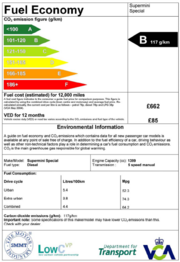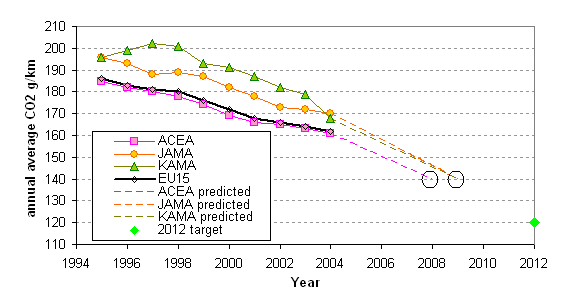European Union vehicle emissions regulations
From DDL Wiki
Contents |
Carbon dioxide emission regulations
In the European Union (EU), road transport is one of the few sectors where emissions are still rising rapidly. It contributes about one-fifth of the EU's total emissions of carbon dioxide, the main greenhouse gas. Although there have been significant improvements over recent years in vehicle technology - particularly in fuel efficiency, which translates into lower CO2 emissions - these have not been enough to neutralize the effect of increases in traffic and car size. CO2 emissions from road transport rose by 26% between 1990 and 2004. <ref>Proposal for REGULATION OF THE EUROPEAN PARLIAMENT AND OF THE COUNCIL: Setting emission performance standards for new passenger cars as part of the Community's integrated approach to reduce CO2 emissions from light-duty vehicles. [1]</ref>
Original Strategy in 1995
The original strategy for CO2 emissions reduction was proposed by the EC in 1995 with the supported of European Parliament. It has three main subjects:
- Mandatory labeling for consumer information
- An EU directive requires that each new car display a label showing its fuel consumption and CO2 emissions.<ref>Comparative Colour Coded Label. http://www.dft.gov.uk/pgr/roads/environment/research/consumerbehaviour/comparativecolourcodedlabels3819?page=6</ref> Moreover, car advertisements that references a specific make and model need to reveal fuel use and CO2 emissions in way that is easy to understand according to EU directive 1999/94/EC.<ref> relating to the availability of consumer information on fuel economy and CO2 emissions in respect of the marketing of new passenger cars. http://ec.europa.eu/environment/co2/9994/en.pdf</ref>
- Voluntary agreements with car markers
- The automakers need to make voluntary commitments to reduce CO2 emissions from their new cars sold in the EU to an average of 140 g/km by 2008 (for European manufacturers) or 2009 (for Japanese and Korean manufacturers).
- ACEA - European Automobile Manufacturers Association
- JAMA - Japan Automobile Manufacturers Association
- KAMA - Korean Automobile Manufacturers Association
- Promoting fuel-efficient cars through fiscal measures
- EC has proposed EU legislation aimed at including a CO2 element in national car taxes.
Proposal for mandatory CO2 emission regulation
In 1993, to help reduce greenhouse gas emissions and meet its Kyoto Protocol targets, the EU has agreed that average CO2 emissions from new passenger cars should not exceed 120 grams of CO2 per km by 2012 according to Directive 93/116/EC<ref>European Commission Directive 93/116/EC. [2]</ref>.
In 2005, the European Parliament passed a resolution in support for mandatory CO2 emission standards to replace current voluntary commitments since some major automakers' performances on reducing CO2 emission are found unsatisfactory.<ref>European Parliament resolution on "Winning the Battle Against Global Climate Change" (2005/2049(INI)) [3]</ref>
In 2007, a new proposal was initiated for a regulation of the European Parliament and of the Council setting emission performance standards for new passenger cars as part of the Community's integrated approach to reduce CO2 emissions from light-duty vehicles. <ref>European Commission. 2007. Dec. 19, 2007. http://eur-lex.europa.eu/LexUriServ/LexUriServ.do?uri=COM:2007:0856:FIN:EN:HTML</ref> based on an analysis report for auto manufacturers' CO2 reduction report<ref>Communication from the Commission to the Council and the European Parliament: Results of the review of the Community Strategy to reduce CO2 emissions from passenger cars and light-commercial vehicles (COM/2007/0019 final). Feb. 7, 2007. [4]</ref>. The auto manufacturers may face fines of 10 euros at least (the lowest possible penalty level) for every gram CO2 over the limit of 120g/km from a current average of 160g/km. In 2015 the penalty will rise to 95 euros as the highest possible penalty level. <ref>Reuters, Carmakers may face billions in CO2 penalties-papers, Dec 12, 2007. [5]</ref>
On December 17th, 2008, European Commission determined new schedule to phase in the CO2 emission standard with increasing percentage levels from 2012 to 2015 for the 130 g/km mid-term target<ref>http://www.europarl.europa.eu/sides/getDoc.do?pubRef=-//EP//TEXT+TA+P6-TA-2008-0614+0+DOC+XML+V0//EN&language=EN#top</ref><ref>http://ec.europa.eu/environment/air/transport/co2/co2_home.htm</ref>: 2012: 65%; 2013: 75%; 2014: 80%; 2015: 100%
| Year | Type | CO2 emission | gasoline MPG | Remark |
|---|---|---|---|---|
| 1995 | voluntary | 186 g/km | 29.3 | |
| 2004 | voluntary | 163 g/km | 33.5 | 12.4% reduction from 1995 |
| 2008 | voluntary | 140 g/km | 39.0 | 2008 target |
| 2012 | mandatory | 130 g/km (65%) | 45.5 | proposal |
| 2013 | mandatory | 130 g/km (75%) | 45.5 | proposal |
| 2014 | mandatory | 130 g/km (80%) | 45.5 | proposal |
| 2015 | mandatory | 130 g/km (100%) | 45.5 | proposal |
| 2020 | mandatory | 95 g/km | 57.5 | long-term target |
The penalty amount is determined by different level of violations over the minimum CO2 emission target. For 2012-2018, the penalty settings are:
- €5 for the first gram over the target
- €15 for the second g/km over the target
- €25 for the third g/km over the target
- €95 for the fourth g/km and subsequent
After 2019, violation per g/km will be €95.
On April 23, 2009, the legislation on CO2 emissions for passenger cars was published in Regulation (EC) No 443/2009 of the European Parliament and of the Council <ref>Regulation (EC) No 443/2009 of the European Council: Setting emission performance standards for new passenger cars as part of the Community's integrated approach to reduce CO2 emissions from light-duty vehicles. http://eur-lex.europa.eu/LexUriServ/LexUriServ.do?uri=CELEX:32009R0443:EN:NOT</ref>.
Non-carbon dioxide emission regulation
The non-CO2 pollutant emissions for the vehicles sold in European are regulated separately for light-duty vehicles (cars and light vans) and for heavy-duty vehicles (trucks and buses). <ref>Transport and Environment: Some key topics, http://ec.europa.eu/environment/air/transport.htm#1</ref>
The regulations mainly provides two sets of standards for diesel and gasoline vehicles and also for different size of vehicles:
- Passenger cars
- Light commercial vehicles
- Light commercial vehicles ≤1305 kg (Category N1 - I)
- Light commercial vehicles 1305 kg-1760 kg (Category N1 - II)
- Light commercial vehicles >1760 kg max 3500 kg. (Category N1 - III), g/km
- Emission standards for lorries and buses
- Emission standards for Large Goods Vehicles
The regulation stages for light duty vehicle are defined using Arabic numerals, such as Euro 1, Euro 2, Euro 3, Euro 4 and Euro 5. The satges for heavy duty vehicles use Roman, such as Euro I, Euro II, Euro III, Euro IV and Euro V.
| Stage | Implement Year | Directive # |
|---|---|---|
| Base | 70/220/EEC<ref>Directive 70/220/EEC. [6]</ref> | |
| Euro 1 | 1993 | 91/441/EEC(cars)<ref>Directive 91/441/EEC. [7]</ref> 93/59/EEC(light trucks)<ref>Directive 93/59/EEC. [8]</ref> |
| Euro 2 | 1996 | 94/12/EC<ref>Directive 94/12/EC. [9]</ref> (& 96/69/EC<ref>Directive 96/69/EC. [10]</ref>) |
| Euro 3 | 2000 | 98/69/EC<ref>Directive 98/69/EC. [11]</ref> |
| Euro 4 | 2005 | 98/69/EC (& 2002/80/EC<ref>Directive 2002/80/EC. [12]</ref>) |
| Euro 5 | 2008/9 | (COM(2005)683-proposed)<ref>Proposal for a REGULATION OF THE EUROPEAN PARLIAMENT AND OF THE COUNCIL on type approval of motor vehicles with respect to emissions and on access to vehicle repair information, amending Directive 72/306/EEC and Directive. Dec, 21. 2005 [13]</ref> |
Other Programs
CAFE Program
Clean Air for Europe (CAFE) launched in March 2001 is a program to carry out technical analysis and policy development that underpinned the development of the Thematic Strategy on Air Pollution.<ref> The CAFE Programme - Implementation of the Thematic Strategy on Air Pollution. http://ec.europa.eu/environment/air/cafe/index.htm</ref> The major elements of the CAFE program are:
- Thematic Strategy on Air Pollution (COM(2005) 446)<ref>COM(2005) 446. http://eur-lex.europa.eu/LexUriServ/site/en/com/2005/com2005_0446en01.pdf</ref>
- Annexes to the Thematic Strategy are in SEC (2005) 1132<ref>SEC(2005) 1132. http://ec.europa.eu/environment/air/cafe/pdf/annex_sec_2005_1132_en.pdf</ref>
- Directive on Ambient Air Quality and Cleaner Air for Europe (the CAFE Directive) (COM(2005) 447)<ref>COM(2005) 447. http://ec.europa.eu/environment/air/cafe/pdf/com_2005_447_en.pdf</ref>
- Impact Assessment of the Thematic Strategy and the CAFE Directive (SEC(2005) 1133)<ref>The Communication on Thematic Strategy on Air Pollution and The Directive on Ambient Air Quality and Cleaner Air for Europe. Commission working paper. Sec(2005) 1133. Sep. 21, 2005. http://ec.europa.eu/governance/impact/docs/ia_2005/sec_2005_1133_en.pdf </ref>
Auto-Oil Program
Auto-Oil Program focused on the emissions of carbon monoxide (CO), Volatile Organic Compounds (VOC), nitrogen oxides (NOx) and particles.
References
<references/>


